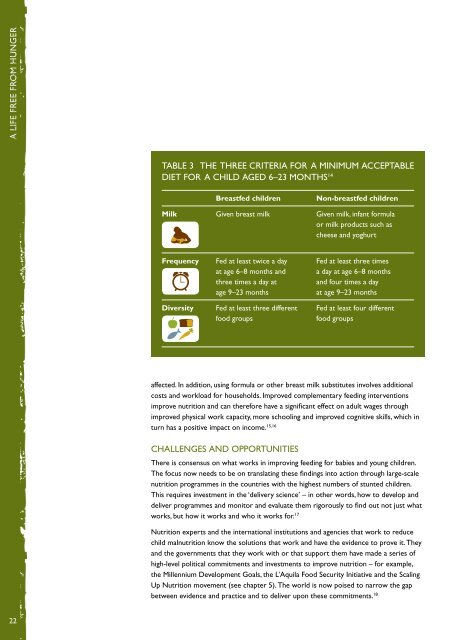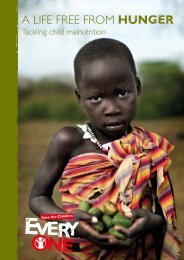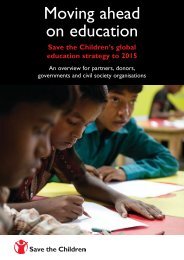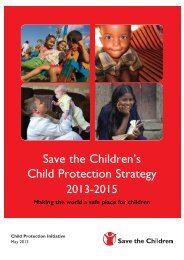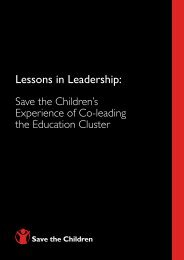NGER A LIFE FREE FROM HUNGER - Save the Children
NGER A LIFE FREE FROM HUNGER - Save the Children
NGER A LIFE FREE FROM HUNGER - Save the Children
You also want an ePaper? Increase the reach of your titles
YUMPU automatically turns print PDFs into web optimized ePapers that Google loves.
a life free from hunger<br />
TABLE 3 THE THREE CRITERIA FOR A MINIMUM ACCEPTABLE<br />
DIET FOR A CHILD AGED 6–23 MONTHS 14<br />
Breastfed children<br />
Non-breastfed children<br />
Milk Given breast milk Given milk, infant formula<br />
or milk products such as<br />
cheese and yoghurt<br />
Frequency Fed at least twice a day Fed at least three times<br />
at age 6–8 months and a day at age 6–8 months<br />
three times a day at<br />
and four times a day<br />
age 9–23 months<br />
at age 9–23 months<br />
Diversity Fed at least three different Fed at least four different<br />
food groups<br />
food groups<br />
affected. In addition, using formula or o<strong>the</strong>r breast milk substitutes involves additional<br />
costs and workload for households. Improved complementary feeding interventions<br />
improve nutrition and can <strong>the</strong>refore have a significant effect on adult wages through<br />
improved physical work capacity, more schooling and improved cognitive skills, which in<br />
turn has a positive impact on income. 15,16<br />
CHALLENGES AND OPPORTUNITIES<br />
There is consensus on what works in improving feeding for babies and young children.<br />
The focus now needs to be on translating <strong>the</strong>se findings into action through large-scale<br />
nutrition programmes in <strong>the</strong> countries with <strong>the</strong> highest numbers of stunted children.<br />
This requires investment in <strong>the</strong> ‘delivery science’ – in o<strong>the</strong>r words, how to develop and<br />
deliver programmes and monitor and evaluate <strong>the</strong>m rigorously to find out not just what<br />
works, but how it works and who it works for. 17<br />
Nutrition experts and <strong>the</strong> international institutions and agencies that work to reduce<br />
child malnutrition know <strong>the</strong> solutions that work and have <strong>the</strong> evidence to prove it. They<br />
and <strong>the</strong> governments that <strong>the</strong>y work with or that support <strong>the</strong>m have made a series of<br />
high-level political commitments and investments to improve nutrition – for example,<br />
<strong>the</strong> Millennium Development Goals, <strong>the</strong> L’Aquila Food Security Initiative and <strong>the</strong> Scaling<br />
Up Nutrition movement (see chapter 5). The world is now poised to narrow <strong>the</strong> gap<br />
between evidence and practice and to deliver upon <strong>the</strong>se commitments. 18<br />
22


